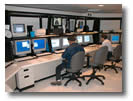The Truth may make you Free, but it is the Talk Groups which keep you Safe.
What the hell is a “talk group”?
Well, it is not the senior citizens who gather at the corner café or feedstore (are my Iowa roots showing?) to discuss the issues of the day? Nope – talk groups are the fundamental element of a public safety voice radio system.
Seattle has five police precincts. One of them – West – got really busy at about 2:00 PM today. A bank robbery occurred at the Bank of America branch in the center of downtown. And the West Precinct “talk group” was filled the voices of dozens of police officers and FBI responding, surrounding the building and searching for the suspect, which they’d caught by 2:30. (Coincidently, at 2:09 PM, an automobile rescue was dispatched to 7700 16th Ave SW, with eight fire units plus police units dispatched – get more details on the City’s website here).
When police and fire departments first started using radio for dispatch and operations in the 1920s, one radio “frequency” was allocated for each precinct or task, such as the West Police Precinct, or a large-scale medic incident such as the auto rescue. We all know what a radio frequency is – “tune to KJR 950 on your radio dial” – 950 kilohertz that is, although most folks don’t know the “kilohertz” part (and the geeks reading this can get a better explanation in Wikipedia) .
Public safety departments were assigned similar frequencies.
Using radio for dispatching and operations is really really useful. So everyone tarted using it! Buses and water utilities and taxis and just about any other operation with a mobile workforce. And, with the advent of cell phones and then wireless data communications such as those offered by the cell phone companies, or wi-fi, the available frequencies rapidly were allocated. In dense urban areas like Seattle, virtually every kilohertz of radio spectrum is allocated to something, or reserved by FCC for a future use.
In fact, the transition to digital TV which is occurring on February 19, 2009 (see the explanation here) is all about freeing more frequencies for other uses. The FCC has also taken TV stations 70 to 83 (UHF) off the air to free frequencies.
In Seattle, however, we only have about 28 radio frequencies for all City government uses. Yet we have hundreds of police and firefighters and utility workers and others on the street at any given time. Plus public safety officers from many other jurisdictions come to Seattle to transport prisoners or attend court. How can we stretch 28 frequencies to cover all those uses?
The answer: “talk groups”. Plus a bit of technology.
Motorola developed a technology called “trunked radio”. Essentially no radio frequency is ever used every second of the time. Even during the bank robbery downtown this afternoon, with dozens of officers listening and talking, there were long gaps between transmissions. Part of this is good training and “radio discipline” by the cops. Motorola’s system allows each transmission to use any available frequency, not just one. In this fashion, dozens or hundreds of “talk groups” (like West Police Precinct) can use the same 28 frequencies, all at the same time, without interference and with plenty of spare capacity. Indeed, during most days, there are over 60,000 individual radio transmissions on the Seattle network, but rarely are more than half the 28 available frequencies in use.
The interesting part: this is 1980s technology! It is 20 years old! Indeed, these radio systems are based, in part, on the Motorola 6809 chip, developed 30 years ago in 1978, and also used in wonderful machines like the Tandy “Color Computer”.
Are these systems getting old? You bet, and they’ll need replacing soon. But for right now, Seattle’s Public Safety Radio system is up and working 99.999% of the time (that is only minutes of downtime a year), a credit not just to solid technology but good maintenance and fast response to problems by the City’s Comm Shop (part of my Department of Information Techology).
This technology – and talk groups like “West Precinct” – help police officers and firefighters keep Seattle safe.









